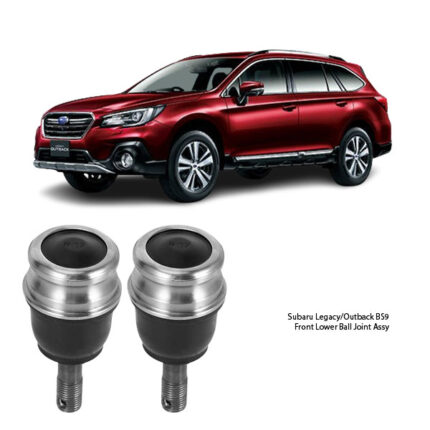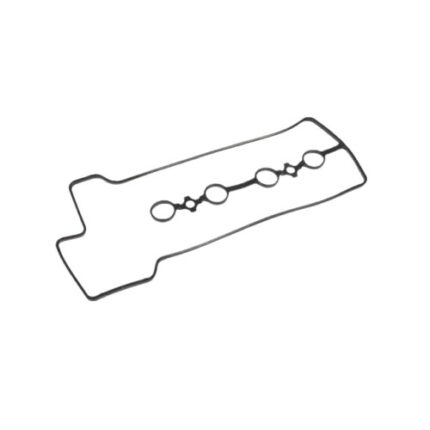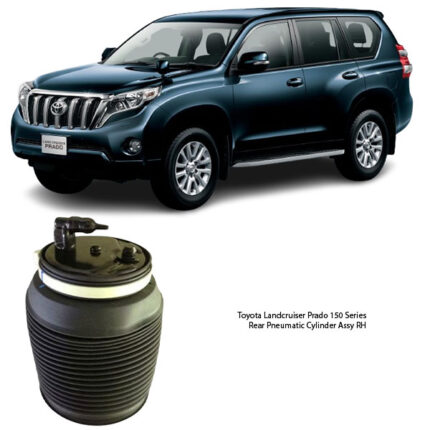Get Toyota Landcruiser Prado 150 Series Rear Pneumatic Cylinder Assy RH 48080-60010 in Kenya
The Rear Pneumatic Cylinder Assembly RH is a vital component in pneumatic suspension systems, particularly those found in vehicles designed for optimal load handling and ride comfort. Positioned on the rear right-hand side, this assembly contributes significantly to maintaining vehicle stability, adjusting ride height, and enhancing driving dynamics under varying load conditions.
In this detailed guide, we will explore what the Rear Pneumatic Cylinder Assembly does, why it’s important, symptoms of a failing cylinder, how to replace it, and how to maintain it for long-term performance.
What is a Rear Pneumatic Cylinder Assembly?
A Rear Pneumatic Cylinder Assembly is part of the vehicle’s air suspension system, which replaces traditional coil or leaf spring suspensions with air springs or pneumatic actuators. The assembly typically includes a cylinder, air bladder, piston, seals, and mounting hardware. It uses compressed air to control the suspension height and damping characteristics based on driving conditions and load weight.
The right-hand (RH) designation indicates that this specific cylinder is designed to be installed on the rear passenger side of the vehicle.
Functions of the Rear Pneumatic Cylinder
The key functions of the Rear Pneumatic Cylinder Assembly include:
-
Ride Height Control: Automatically adjusts the rear height of the vehicle depending on the load and road conditions, ensuring a level ride and consistent ground clearance.
-
Load Compensation: Maintains optimal suspension geometry and vehicle posture by adapting to the weight carried over the rear axle.
-
Shock Absorption: Works in tandem with dampers or struts to absorb shocks from road irregularities, improving ride comfort.
-
Stability Enhancement: Ensures vehicle stability by keeping the chassis balanced and minimizing sway or body roll, especially when cornering or towing.
-
Reduced Wear on Components: Distributes loads evenly across the suspension system, reducing stress on axles, bushings, and other parts.
Advantages of a High-Quality Pneumatic Cylinder Assembly
Investing in a durable and well-engineered Rear Pneumatic Cylinder Assembly offers multiple benefits:
-
Enhanced Ride Comfort: The system adapts quickly to changes in terrain, reducing vibrations and providing a smoother driving experience.
-
Improved Handling: By keeping the vehicle level, it allows for better control, especially when braking or navigating sharp turns.
-
Long-Term Suspension Health: Reduces mechanical strain on other components, thereby prolonging the life of suspension parts.
-
Fuel Efficiency: A level vehicle experiences less aerodynamic drag and more efficient weight distribution, which can contribute to better fuel economy.
-
Versatility: Air suspension allows the vehicle to perform well in diverse conditions — from city streets to off-road environments or heavy-load scenarios.
Symptoms of a Faulty Rear Pneumatic Cylinder Assembly
Over time, the pneumatic cylinder may begin to show signs of wear or failure due to aging materials, exposure to environmental elements, or internal seal breakdown. Some of the most common warning signs include:
-
Sagging Suspension: The right rear side of the vehicle appears lower than the rest, especially after the vehicle has been parked overnight.
-
Unusual Noises: Hissing sounds (from air leaks) or clunking noises (from internal damage) during operation may indicate cylinder failure.
-
Vehicle Leans or Tilts: A constant lean toward one side suggests that the air spring is not maintaining pressure.
-
Increased Bounciness: Reduced shock absorption leads to a noticeable bouncy or unstable ride, especially over bumps or uneven terrain.
-
Air Compressor Overworking: If the cylinder is leaking, the compressor runs more frequently to maintain air pressure, potentially leading to compressor burnout.
-
Warning Lights: Some vehicles equipped with pneumatic suspension systems will trigger a dashboard warning when the system malfunctions.
If any of these symptoms are present, it’s crucial to inspect and, if necessary, replace the Rear Pneumatic Cylinder Assembly to restore safe driving conditions.
Replacement Process for Rear Pneumatic Cylinder Assembly RH
Note: Pneumatic suspension repairs involve high-pressure air systems and vehicle lifting equipment. If you’re not experienced in mechanical repairs, consult a qualified technician.
Required Tools and Equipment:
-
Jack and jack stands or a hydraulic lift
-
Socket set and wrenches
-
Torque wrench
-
Screwdrivers
-
Air suspension system scanner (if available)
-
Replacement pneumatic cylinder assembly
-
Safety gloves and goggles
Step-by-Step Replacement Guide:
-
Preparation: Park the vehicle on a level surface. Engage the parking brake and disconnect the battery.
-
Raise the Vehicle: Safely lift the rear of the vehicle and support it with jack stands.
-
Depressurize the System: Release air from the system using the vehicle’s onboard controls or diagnostic tool. This ensures safe removal of air lines.
-
Remove the Wheel: Take off the rear right-hand wheel to access the suspension assembly.
-
Disconnect Air Lines: Carefully remove the air lines from the cylinder. Avoid twisting or bending the connections.
-
Detach the Cylinder: Unbolt the cylinder from the suspension bracket and chassis mounts. Depending on design, you may also need to disconnect height sensors or electrical connectors.
-
Install the New Cylinder: Position the new pneumatic cylinder and bolt it securely in place. Reconnect the air line and any electrical sensors.
-
System Re-pressurization: Reconnect the battery. Use a diagnostic tool or the vehicle’s onboard system to refill the air system and calibrate height if needed.
-
Check for Leaks: Spray soapy water around fittings and check for air bubbles indicating leaks.
-
Lower the Vehicle and Test Drive: Carefully lower the vehicle and take it for a test drive to ensure the suspension is functioning properly.
Maintenance Tips for Long Service Life
To extend the lifespan of the Rear Pneumatic Cylinder Assembly RH, consider the following maintenance practices:
-
Regular Inspections: Periodically check the air springs and cylinder housing for signs of damage, corrosion, or leaks.
-
Keep Connections Clean: Ensure that air lines and connectors remain free from dirt and debris to prevent blockages or leaks.
-
Monitor Suspension Performance: Be aware of changes in ride height, handling, or compressor activity — early signs of potential issues.
-
Avoid Overloading: Stick within your vehicle’s payload limits to reduce undue stress on the air suspension system.
-
Check System Calibration: Have the air suspension system recalibrated by a technician after replacement or repairs to maintain proper height control.
-
Protect from Elements: In harsh climates, undercoating or protective sprays can help shield the cylinder from rust and corrosion.
Follow us on Facebook for more parts.





Reviews
Clear filtersThere are no reviews yet.